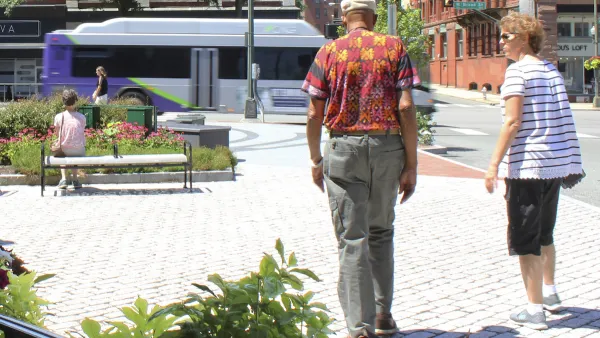Approximately 6,000 urban planners arrive in San Francisco for the annual American Planning Association conference.
More than 6,000 urban, rural and regional planners from across the country and abroad are in San Francisco this week to attend the American Planning Association's (APA) 2005 National Planning Conference at San Francisco's Moscone West convention center from Saturday, March 19 to Wednesday, March 23. Planning experts will address topics such as bicycle and pedestrian planning, disaster mitigation, wild fires, safe growth, new urbanism and affordable housing.
The conference offers more than 300 sessions addressing the challenging issues of growth and change communities face across the country. Special conference tracks include safe growth, small town and rural planning, new urbanism, the planner's role in food systems, and housing.
The conference opened on Sunday morning with a keynote address by Judith Rodin, president of the Rockefeller Foundation and former president of the University of Pennsylvania, where in 1994, she made history as the first woman named president of an Ivy League institution. Her talk focused on the restoration of the fabric and economic vitality of the University of Pennsylvania's distressed urban neighborhood. This revitalization required a strategic approach with interventions at multiple levels, including improving safety, enhancing housing, developing economic capacity, creating retail, and restoring quality public education. The university's approach was informed by research and planning literature and its own expertise and experience. The plan led to the development of an urban campus which is reknit into the surrounding community.
After a full day of sessions, the fabulous opening reception was held Sunday evening at Fort Mason Center, once an active military facility and now a thriving cultural center within the Golden Gate National Recreation Area. This National Historic Landmark lies on the edge of San Francisco Bay, with spectacular views of the Golden Gate Bridge and Alcatraz.
Thanks to Chris Steins
FULL STORY: Urban planners put microscope on Bay Area

Planetizen Federal Action Tracker
A weekly monitor of how Trump’s orders and actions are impacting planners and planning in America.

Vehicle-related Deaths Drop 29% in Richmond, VA
The seventh year of the city's Vision Zero strategy also cut the number of people killed in alcohol-related crashes by half.

Can We Please Give Communities the Design They Deserve?
Often an afterthought, graphic design impacts everything from how we navigate a city to how we feel about it. One designer argues: the people deserve better.

Southern Californians Survey Trees for Destructive Oak Pest
Hundreds of volunteers across five counties participated in the first Goldspotted Oak Borer Blitz, surveying oak trees for signs of the invasive beetle and contributing valuable data to help protect Southern California’s native woodlands.

Opinion: How Geothermal HVAC Lowers Costs, Improves Grid Resilience
Geothermal heating and cooling systems can reduce energy costs and dramatically improve efficiency.

Tenant Screening: A Billion-Dollar Industry with Little Oversight. What’s Being Done to Protect Renters?
Reports show that the data tenant screening companies use is often riddled with errors and relies on information that has no bearing on whether someone will be a good tenant.
Urban Design for Planners 1: Software Tools
This six-course series explores essential urban design concepts using open source software and equips planners with the tools they need to participate fully in the urban design process.
Planning for Universal Design
Learn the tools for implementing Universal Design in planning regulations.
Borough of Carlisle
Smith Gee Studio
City of Camden Redevelopment Agency
City of Astoria
Transportation Research & Education Center (TREC) at Portland State University
City of Camden Redevelopment Agency
Municipality of Princeton (NJ)


























